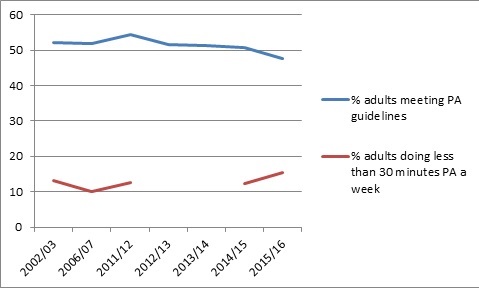We campaign for a more bike-friendly city for all sorts of reasons – it’s fun; it’s a smart and cheap way to add transport capacity to existing roads; it’s a brilliantly efficient way to address our climate change imperatives… and of course, going by bike is actively good for you.
The health angle is boosted by recent news that New Zealand kids are becoming less and less active and independent – and more and more adults aren’t even meeting the basic minimum recommendations for physical activity.
In that context, creating cities that give people the chance to walk and bike for everyday travel is a public health no-brainer. This is borne out by recent research by Dr Caroline Shaw and colleagues at the University of Otago. Our thanks to Caroline and the University of Otago for letting us share her summary, below:
Walking and cycling for transport is good for physical activity levels in Kiwis!
Physical activity is good for health. Higher levels of physical activity are associated with reduced rates of breast and colon cancer, better mental health, lower obesity rates, lower heart disease, stroke (the list goes on).
This blog looks at a new study we just published that found that New Zealanders who walk or cycle to their main activity each day have a 76% higher chance of achieving the Ministry of Health physical activity guidelines than those who drive cars.
Despite the overwhelming evidence of the benefits of physical activity, less than half of New Zealanders now meet the Ministry of Health physical activity guidelines, which should really be considered a bare minimum for health (see Figure 1). In addition, an alarming 1 in 6 of us do less than 30 minutes physical activity each week.

So it seems that whatever the health sector is doing to promote physical activity in New Zealanders, is not working. And that is not surprising; we have engineered opportunities for physical activity almost entirely out of our lives. Increasingly, the only way to get physical activity is by doing some sort of specific activity (e.g. going to a gym) that needs to be squeezed into already busy lives. So it is hardly surprising that physical activity is declining.
The promotion of active travel (walking and cycling) and public transport (which is usually accompanied by walking trips at each end) is thought to be one of the most effective ways to create enduring increases in physical activity levels in the population.1 Interventions to increase active travel and public transport may also have other positive impacts such as improved air quality, decreased traffic congestion and carbon emissions, decreased crime and increased social connectedness.1
Our newly published study, in the Journal of Transport and Health, looked at whether New Zealanders who walk, cycle or take public transport to their main activity (work, university etc) each day are more likely to meet the NZ physical activity guidelines than those who take the car. We found that New Zealanders who walk or cycle to their main activity each day have a 76% higher chance (odds) of achieving the Ministry of Health physical activity guidelines than those who drive cars. When we looked at this association for people who are in work or not in work, it holds for both groups.
This study also found that people who take public transport are no more likely to meet the physical activity guidelines than those who drive cars (OR 1.15 95%CI 0.80-1.65). This was a somewhat unexpected finding, as internationally there is evidence that people who take public transport do have higher levels of physical activity than those who drive cars.2 The lack of statistical significance may be related to the sample size – only a small number of people in this survey who actually took public transport (250 out of about 5000) as, for NZ overall, taking public transport is a minority transport mode. We need to do more work in this area to confirm or refute this finding.
We know from studies overseas that active commuting increases overall physical activity levels, and is not ‘offset’ by reductions in physical activity in other areas. Longitudinal studies that follow up people who start active commuting show they increase their overall physical activity – and, conversely, people who stop active commuting reduce their overall physical activity.3-5
We also know that people who take up active commuting:
- reduce their weight (and the reverse is true for people who stop active commuting),6,7
- reduce their risk of diabetes,8
- reduce their work sickness absence,9
- and reduce their risk of cardiovascular disease and all-cause mortality.10
Our study also looked at who walks, cycles and takes public transport in New Zealand; showing that people who use these modes of transport are more likely to be younger, with lower incomes and are predominantly men. This may be problematic for policy development; we know that some of the opposition to new infrastructure for commuter cycling, for example, represents a clash in perceived values between those who cycle and those who do not. Having a more representative group of society using these modes of transport may be useful to alleviate some of the culture wars.
In summary, our new study contributes to the growing body of evidence showing that active transport is an effective way of increasing physical activity for New Zealanders and therefore lowering many disease risks. The important questions to focus on now are what are the best policies and incentives to increase active transport levels and how to ensure that people who are currently insufficiently active for health have easy options to take up active transport if they wish.
References
- Giles-Corti B, Vernez-Moudon A, Reis R, et al. City planning and population health: a global challenge. Lancet 2016; 388(10062): 2912-24.
- Rissel C, Curac N, Greenaway M, Bauman A. Physical activity associated with public transport use–a review and modelling of potential benefits. Int J Environ Res Public Health 2012; 9(7): 2454-78.
- Panter J, Heinen E, Mackett R, Ogilvie D. Impact of New Transport Infrastructure on Walking, Cycling, and Physical Activity. Am J Prev Med 2016; 50(2): e45-53.
- Foley L, Panter J, Heinen E, Prins R, Ogilvie D. Changes in active commuting and changes in physical activity in adults: a cohort study. Int J Behav Nutr Phys Act2015; 12(1): 161.
- Sahlqvist S, Goodman A, Cooper AR, Ogilvie D, iConnect c. Change in active travel and changes in recreational and total physical activity in adults: longitudinal findings from the iConnect study. Int J Behav Nutr Phys Act 2013; 10(1): 28.
- Martin A, Panter J, Suhrcke M, Ogilvie D. Impact of changes in mode of travel to work on changes in body mass index: evidence from the British Household Panel Survey. J Epidemiol Community Health 2015; 69(8): 753-61.
- Mytton OT, Panter J, Ogilvie D. Longitudinal associations of active commuting with body mass index. Prev Med 2016; 90: 1-7.
- Rasmussen MG, Grøntved A, Blond K, et al. Associations between Recreational and Commuter Cycling, Changes in Cycling, and Type 2 Diabetes Risk: A Cohort Study of Danish Men and Women. PLoS Med 2016; 13(7): e1002076.
- Mytton OT, Panter J, Ogilvie D. Longitudinal associations of active commuting with wellbeing and sickness absence. Prev Med 2016; 84: 19-26.
- Celis-Morales CA, Lyall DM, Welsh P, et al. Association between active commuting and incident cardiovascular disease, cancer, and mortality: prospective cohort study. BMJ 2017; 357.




